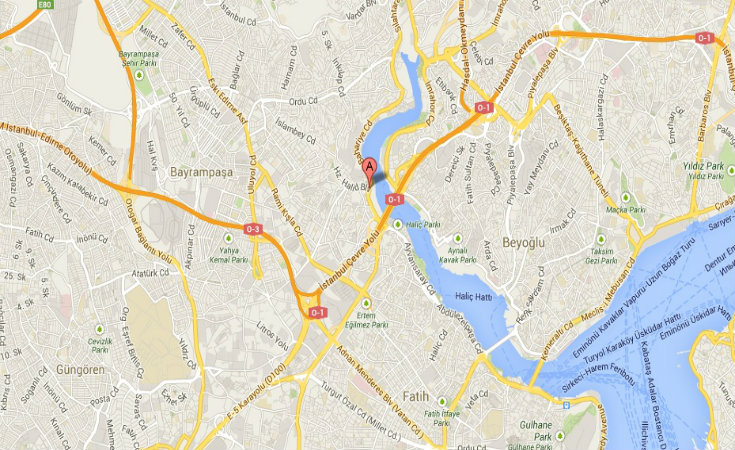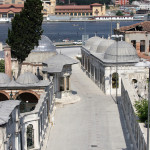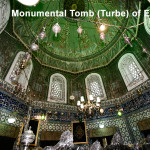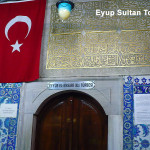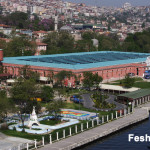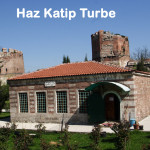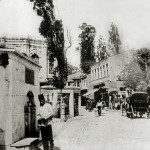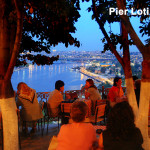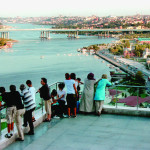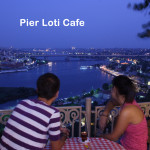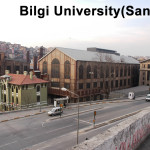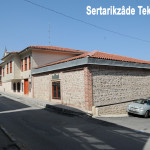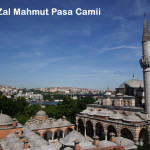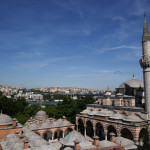Eyüpsultan Complex
Ebu Eyyûb el-Ensarî, in Turkish known as Eyup Sultan was the holy person who hosted Prophet Muhammed in his house during his journey from Mekka to Medina. Prophet Muhammed. Later he became the companion and the standard-bearer of the prophet Muhammed. He was at an older age and joined the siege of Constantinople during Arab attacks. He died outside the city walls in 670. After the conquest of Constantinople by Fatih Sultan Mehmet, his tomb was redicscovered by the teacher of Fatih and the whole area was rebuilt. His tomb is greatly frequented by all Muslims, especially during Ramadan and pilgrimage month. Some of the personal belongings of Muhammad are preserved in the building that houses the tomb.
The first Eyup Sultan Mosque was built in 1458. Mosque is right next to Eyup Sultan’s (Abu Ayyub Al-Ansari’s) grave (Turbe). In 1800, the whole building complex was reconstructed by Sultan Selim III. Since Eyup Sultan’s Turbe (monumental grave) is here, the area has been very popular since the Ottoman Ages: many high rank government officials as well as religious leaders have been burried here. Therefore, there is a large Ottoman graveyard surrounding Eyup Sultan Mosque and Turbe.
Tomb of Eyüp Sultan
The burial place of Ebu Eyyub-el Ensari, Standard-bearer to the Prophet Muhammed, who died during the siege of Constantinople by the Arabs in the 8th century, was discovered by Aksemseddin durin the siege of the city by Mehmed the Conqueror.
On Aksemsettin’s doscovery of the grave of Halid bin Zeyd Ebu Eyyub-el Ensari, Mehmed the Conqueror gave orders that a tomb should be built over the grave. The construction of the tomb was begun in 1453 during the first days of the siege Constatiople . Various additions were later made to the tomb erected by Mehmed the Conqueror but the tomb it self is original. A comprehensive restoration is now being undertaken.
Semiz Ali Pasha (d.1621) and the Grand Vizier Gürcü Mehmed Pasha (1575-1623) are buried in the Cuzhane beside the tomb of Halid. After the reign of Mehmed the Conqueror two “martyrs” (soldiers who fell in a holy war) were buried by the side of Halid’s grave. Later a number of statesmen, scholars and artists wished to be buried near Eyup Sultan.
Several distinguished personalities were buried in the Eyup Sultan tomb graveyard.: Gazi Ethe Pasha, Kucuk Said Pasha, Mehmed the Conqueror’s water carrier, Mustafa Agha, Yusuf Baba, Hoca Sinan Pasha, Muhsinzade Mehmed Pasha, Esma Sultan Sheikh Sadreddini Acemi, Hasan-ı Sansuni, Ali bin Mehmed el-Kuşçu, Muhyiddin bin Muhammed bin Abdulevvel-i Tebrizi Mahmud Zihni Efendi, İzzet Pasha, Yusuf Sinan Pasha, Mehmed Sevki, Mustafa Asim, Müeyyedzade Abdurrahman, Zubeyde Fitnat Hanim.
The tomb recently underwent a comprehensive restoration and will soon be reopened to the public.
Coronation Road
From the Sokollu Mehmet Pasha Madrasah a path popularly known as “Âşıklar Yolu”(lovers’ lane), which has made its appearance in many historical films, leads to the “Coronation Road” that begins from the rear entrance to Eyup Msque.
The “Coronation Roas”, on which all the Ottoman Sultans from Sultan Mehmet to Vahdettin would perform the coronation ceremony of girding the sword on horse back, is a road rich in history symbolising the sovereignty of the Sultan. According to tradition, the would sail to Eyup in the Imperial Caique where he would be greeted by the viziers and high state dignitaries, after which he would mount his horse at the mounting block and pay a visit to Eyup Sultan. From there he pass through the courtyard between the tomb and Eyup Sultan Mosque where the actual coronation ceremony would begin. At a sign from the Sultan the Sheikhulislam would come and gird him with the one of the swords belonging to the four Caliphs and pray for God’s asistance in his victory over enemies of religion or the state. After the ceremony the Sultan would remound his horse and return to Topkapi Palace scattering largesse to the crowds that had gathered on the Edirnekapi road and visiting the tombs of his ancestors on the way.
The mounting block on the Coronaion Road on which the Ottoman Sultans placed their foot in the first step one the way to a reign that was to mark a particular era is stil open to public view.
The “Coronation Road” is also the scene of the “iftar meals” (braking the fast during Ramazan) arranged by the Eyup Municipal Authority.
Feshane
During the 18th centuries, Istanbul grew towards end of Golden Horn, and thus Eyup Sutan area was settled with refugees from Ottoman communities in the Balkans and the Caucasus who came to the city. Thus the district of Eyüp area was incorporated into the city, still keeping its spiritual value but becoming and industrial region as well.
The first factory was the Feshane, the factory on the Golden Horn where FESes were manufactured for the Ottoman armies. Fes was the typical hat for the Ottomans for centuries. The Feshane today is a fairground and exhibition center owned by the Istanbul municipality. The Feshane was opened in 1839 by a decree issued by Sultan Abdulmejit fort he production of fezes and aba(coarse woolen cloth). Built in 1851, it was the first textile factory in the true sense of the word to be opened in this country. It was assembled from elements imported from Belgium and was thus one of the first examples in the world of prefabricated steel construction. In 1866 it was borught up to date with the installation of the latest steam-powered weaving looms, It was awarded a number of gold medals in the 3rd International Paris Exhibition of 1855, the Istanbul “Sergi-i Umum-i Osman-i” (General Ottoman Exhibition) of 1860 and the Chicago Internatonal Exhibition of 1893. In 1939 the then “Feshane Mensucat AŞ” (Feshane Textile Ltd.) was closed down and converted into the “Sumerbank Defterdar Factory”. The factory had been vacated in line with work being carried out on the layout of the environment, but in 1986 the large weaving department of 8,000m² was restored to its original state.
One should just walk from Eyup to Feshane to see the actvities. Every few days the activities at Feshane change: especially promoting diverse cities and cultures of modern Turkey. In recent years the Feshane International Fair Congress and Culture Centre has come to play an increasingly mportant role in the cultural and artistic life of İstanbul. At the presedent day the center place host to activities by every type of organization – seminars, receptions, conferences, concerts, galas and faairs. This historic building, with its Mahmut II Salon, its Golden Horn Salon, its Bedesten Salon, its Sadabat Salon, its Tulip Restaurant and its gren spaces and parks, adds a very particular flavor to the Golden Horn.
Pier Loti Cafe
Pierre Loti, French military captain and writer, stayed in istanbul for some time druing Ottoman period, and wrote the book Aziyade in 1879. The cafe is also called Pier Loti Cafe. The extra-ordinarily beautiful view of Golden Horn from this hill is unique.
The long series of steps leading up through the graveyard by the side of Eyüp Sultan Mosque takes us to the top of the hill known as the Rabia Kadın Coffeehouse until thee end of the 19th century when it became known as the Pierre Loti. Here is the Coffeehouse after the famous French writer made it a habit to come here to drink his coffee. Four years it has been a favourite spot for young lovers and for all those who wish to meet together and find peace and tranquillity far from the noise and bustle of the city. Wooden facilities have been erected to house the hundreds of thousand’s of tourists, mostly French, who visit the spot every year. There is also a cable-car from behind Eyüp Sultan Mosque to Pierre Loti .
Pierre Loti, on the slopes overlooking the Golden Horn, has one of the most beatiful views in İstanbul. As you climb the steps immediately beside the old coffee house bearing the name of Pierre Loti, a writer who was fascinated by oriental culture and included it in various forms in his literaty productions, you will find on your right wooden mansions with all the characteristic features of Ottoman architecture that have replaced the old ramshckle houses that once stood there…
The touristic complex, which preserved the then existing buildings, was completed in 2000. The six konaks serving as a hotel have been given the names of districts adjoining Pierre Loti. The Ayvansaray, Sütlüce, Eyüp, Balat, Hasköy and Fener konaks have been opened to tourism as the Turquhouse Boutique Hotel with a total of 67 rooms and 115 beds. The interior is decorated with objects in comformity with its anrique atmosphere. The ceilings of the restaurant and the café are decorated with the work of traditional calligraphers and decorators.
One can walk up or take the cable car to go upto the hill.
The old toy market
After walking down the Coronation Road in the cool of the morning and taking a short stroll along the shore you will find an additional pleasure in paying a visit to the toy old market.
As a place of relogious pilgrimage Eyup is a popular choice for ceremonies such as circumcision and this has led to the production since the 17th century of toys that might appeal to the young customers. According to Evliya Çelebi in 1635 there were 150 people employed in this market in the production and sale of toys in 100 shops. Toys recyled from the surplus ware in the factories around the Golden Horn were purchased by visitors to the market but the wooden toys made in Eyup could not compete with the toys sold in the shops opened in Pera at the end of the 19th century and in 1957 the construction of the Eyup Boulevard by the then prime minister Adnan Menderes led to demolition of the famous Eyup toy market and the end of Eyup toy production. The revitalisation of Eyup toy production as part of the conservation Project undertaken in the Fener-Balat districts by the Foundation in collaboration with the United States was taken over by the Eyup district on the intervention of the Eyup Municipal Authority. At the same time an attempt is being made to teach Eyup housewifes the art of toy-making and establish sustainable work relationships. The Eyup Municipal Cultural Directorate in Cafer Pasha Madrasah welcomes visitors to its Eyup Toy Workshop.
Tomb of Kaab
This tomb is located near the walls not far from the junction of Ayvansaray Caddesi. Until recently an open tomb, it has been restored and a roof built over it. The tomb of Ka’b, one of the companions of the Prophet, was erecte in 1835.
Zal Mahmut Pasha Mosque
After performing your midday prayers in Zal Mahmut Pasha Mosque, described by Evliya Celebi as one of the most beatiful mosques in İstanbul, you can seize the oppurtunity of taking a closer view of the exquisite architecture in the Zal Mahmut Pasha Külliye, a product of one of the earlier stages of Sinan’s career. Evliya Çelebi refers to the mosque as follows. “The Zal Mahmut Pasha Mosque, one of the most beatiful of mosques, lies on each side of the road through the Garden of Paradise. It is surpassedby none of the vizier mosques on Ottoman soil. The minber, mihrab and the slender columns of the muezzin galleries are rivaled only by thoseI saw in the Sinop castle.”
Zal Mahmut Pasha played a by no means agreeable role in Ottoman history. He was the main actor in the murfer of the Sehzade Mustafa, the eldest son of Suleyman the magnificent, at the instigation of Hurrem Sultan. As a reward he was appointed Governor of Anatolia and married the daughter of Selim II. The kulliye was built in 1566-1568 after his promotion to Pasha. The subsidiary madrasahs in the kulliye now serve as the Mehtern-ı Eyup Sultan (Janissary band centre). The Janissary band gives concerts in Eyup on Fridays, feast days, holidays and evenings. The Zal Mahmut Pasha Complex will once again be open to the public after having undergone a thorough restoration caried out by the Eyup Municipal Council.
Bahariye Mevlevîhanesi
The Bahariye Mevlevîhanesi was founded following the transfer here in 1873 of the Besiktas Mevlevîhanesi founded in 1613 by Ohrili Huseyin Pasha fort he Mevlevî sheikh Agazade Mehmed Dede. Following the closure of the tekkes this tekke, like the others, fell into neglect and disrepair and was finally demolished. The restoration of the Bahariye Mevlevîhanesi, begun in 2007 was completed in 2011. It is now used for activities connected with Turkish art and culture.
Sertarikzade Tekkesi
The Sertarikzade Tekkesi is located on the left hand side of the street at the junction of Davut Ağa Caddesi and İlahiciler Sokagı in the Nisanci district. The tekke was build in the 18th century by Sertarikzâde Mhmed Emin Efend. It has been restored by the Eyup Municipal Authority and used for both indoor and outdoor cultural and social activities.
Bilgi University (Silahtaraga Thermal Electrik Plant)
This construction of this thermal electric plant at the point where the Alibey Kağıthane Construction was begun in 1911 and electricity began to be delivered to the grid in 1914. At the present day the plant and the site has been assigned to Bilgi University and its us efor educational purposes began in 2007. At the same time, a Museum of Modern Art has been opened on the university campus.













